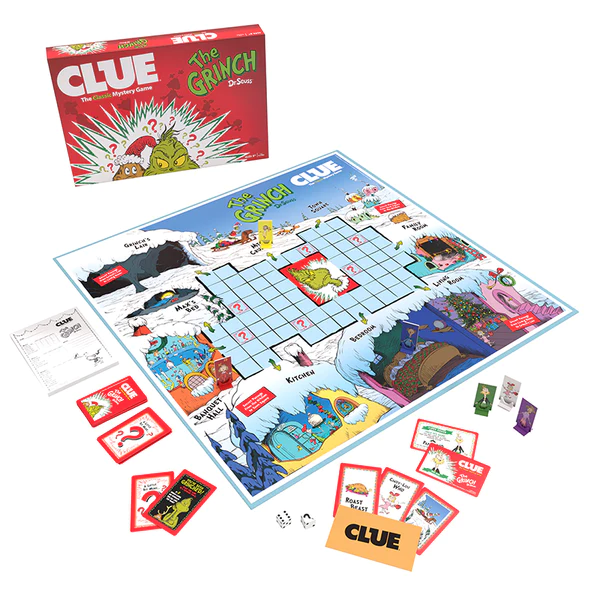A Holiday Classic Becomes a Mystery in Clue: The Grinch

Who saw the Grinch, stealing what, and where? Find out in order to stop him from stealing Christmas in this rethemed version of the classic murder mystery game.
Published by The Op and designed for 2-6 players, Clue: The Grinch is full of Who’s, Christmas, and of course, the Grinch himself.
Gameplay
The board represents a series of rooms connected by movement spaces. There are six character tokens that are all placed in the center space of the board, along with six items. Each player chooses one of the characters to be his own and is given that character’s personality card that comes with a unique, one-time ability you can use during the game.
There are three types of clue cards: characters, items, and locations. You randomly select one of each and slip them into the clue envelope and then shuffle the others together before dealing them as evenly as possible to each player. If any cards are left over, you place them face-up next to the board. The goal of the game is to discover which cards are in the clue envelope.
On your turn you roll the two dice and may move your character up to that number of spaces. If you end your movement in a room, you may guess that location, one item, and one character (you move that character and item into the room with you). Then, starting with the player to your left, each player says if they have at least one card showing one of these three things. If a player has at least one such card, he shows one of the cards to you, without revealing which card it is to the other players. As soon as you have been shown one card, your turn ends without checking with any other players.
When you believe you have figured out which three cards are in the clue envelope, you may make your way back to the central location on the board. Once there, you may make an accusation and name the three cards you believe are in the envelope and then secretly look. If you are right, you won the game. If you are wrong, you are out of the game (but continue to show cards when other players make guesses).
On various spaces on the board there are question marks. If you land on these, if you roll a question mark, or if your character is moved to a location because of a question, then you draw a ‘little bit more’ card. Most of these have special abilities you can play such as seeing a card someone is showing another player in response to a question, but eight of these are Grinch cards. When a grinch card is drawn, you place it face-up next to the board. If all eight grinch cards are ever revealed, all players lose the game.

Review
Clue is a classic for a reason. While some players may find the use of roll-and-move a little dated, the puzzle and deduction is enjoyable, as is the theme. Clue: The Grinch has a few changes, specifically with the board design. Players all start in the center, and there are fewer spaces between locations, meaning you are almost guaranteed to be able to reach a room on your first turn and start making guesses (unless you have the bad luck of rolling two one's).
The Grinch cards are an interesting twist to the original gameplay, serving as both a countdown that can push you to make an accusation before you’re completely positive it’s right, while having opponents draw ability cards means that you’re more careful before dragging them from their plans and into a room to make a guess.
The game has a fun and recognizable theme, and it is nice to have a Christmas-themed game you can play around the holidays. However, the theme doesn’t entirely make sense with the mechanics. You’re all Who’s trying to stop the Grinch from stealing Christmas, but you’re still competing. You can even see him stealing Christmas from his own lair? It comes across as a bit messy. But the components are nice and the board is bright and colorful.
The game is inconsistent with the language it uses across the cards and rulebook. For example, in the rulebook, it is called 'asking a question' when you are testing out card combinations on your turn, but on the personality cards it is referred to as 'starting a rumor.' Also, the rulebook says you draw a ‘little bit more card’ when moved due to an accusation, but from the context it seems clear that it is referring to a question, as you are not moved for an accusation.
If you enjoy Clue and are looking for either a holiday game or something a little more child-oriented, Clue: The Grinch is a fun adaptation of the original, with a few tweaks here and there that work fairly well.
Pros: Shorter distance between locations means less wasted turns getting to locations, fun holiday theme, timing mechanic of the Grinch cards
Cons: Vocabulary is not consistent across rules and components leading to some confusion, the theme is not implemented well with mechanics
Disclosure: we received a complimentary review copy of this game.







